The Mosquito Anode and The Biggest Surfing Waves (Sailing South in Portugal)
From Porto, we day-sailed down the coast, about 50 miles at a time, first to anchor off Aveiro, which was very calm and peaceful despite the infantry barracks and ferry terminal, then to Figueira da Foz where we decided to go into the marina for the night.
Once we had tied up and done the necessaries, I couldn’t be bothered to cook and I didn’t fancy an omelette (Dietmar is amazing but he ain’t no chef…) so we headed out for supper. The restaurant at the end of the marina had been recommended by the marina staff and it was close, so this seemed like a good idea. It really wasn’t. I learned some life lessons that night.
First of all, my suspicion is confirmed that I am in fact Dietmar’s mosquito anode[1]. On the way to the restaurant, I acquired two bites on my forehead so that by the time we arrived, I looked like a young centaur. I try to avoid using DEET so now we have nets rigged in and on the boat, and I use the most natural mosquito-repellent potions I can find, but they LOVE me. I must taste delicious and obviously much yummier than Dietmar who doesn’t appear to have been bitten even once…
Second, don’t ever go to a restaurant where they bring you things to the table that you haven’t yet ordered. First there was bread, then olives, then they brought a selection of starters to show us. It wasn’t exactly what we had in mind, but we chose some king prawns and some local cheese. They were OK, much like the rest of the meal, but, goodness me, the final bill was eye-watering for such an average meal.
Third, ask how big the main course is before you order it. I ordered secretos, which are like fat bacon rashers, and more or less half a pig arrived at the table. Dietmar ordered sea bass. You can imagine. With a couple of loaves of bread, we could genuinely have performed a biblical-style miracle or two. We waded through, as best we could, but there was still so much left over once we were beaten that we asked for a doggy bag to take back to the marina for the very grateful spaniels on Pleithos, the Australian boat opposite us.
We waddled back to the boat, I collected a little cloud of mosquitos to take to bed with me on the way home and Dietmar slept the sleep of the innocent while I bounced in and out of bed with bites and indigestion, between nightmares where I definitely heard the plaintive whine of mosquitos that I had long since dispatched into their next life.

The next morning, with me decidedly bleary from a lack of sleep and Dietmar like Tigger on speed, we headed for the municipal market to victual the boat. the town of Figueira da Foz was a pleasant surprise with its elegant fountains and clean streets and massive, airy market hall filled with delicious offerings under its soaring glass roof. We bought fruit from an elderly woman whose mahogany skin would have matched Cesarina’s interior perfectly. We wanted to buy more than she had, but, not wishing to lose our custom, she scuttled off to buy more bananas for us from a neighbouring stall. We bought bagfuls of fragrant nectarines and oozing fresh figs, then found a fresh fish stall run by two very friendly women whose English was as bad as my Portuguese but with whom smiles, laughter, gestures and a handful of words were enough to buy three fat, glistening-fresh sardines and half a kilo of enormous prawns. We ended up dancing briefly to music that was playing – and grinning a lot – the international language of sisterhood.
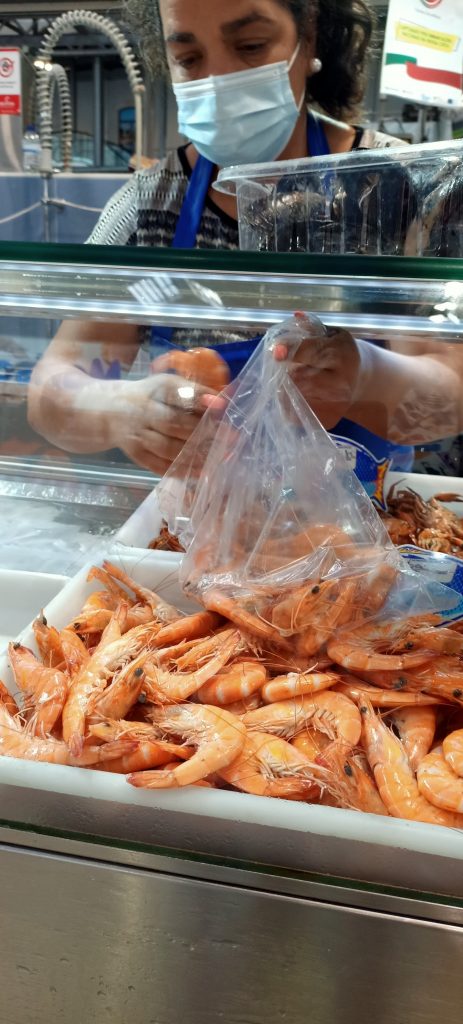
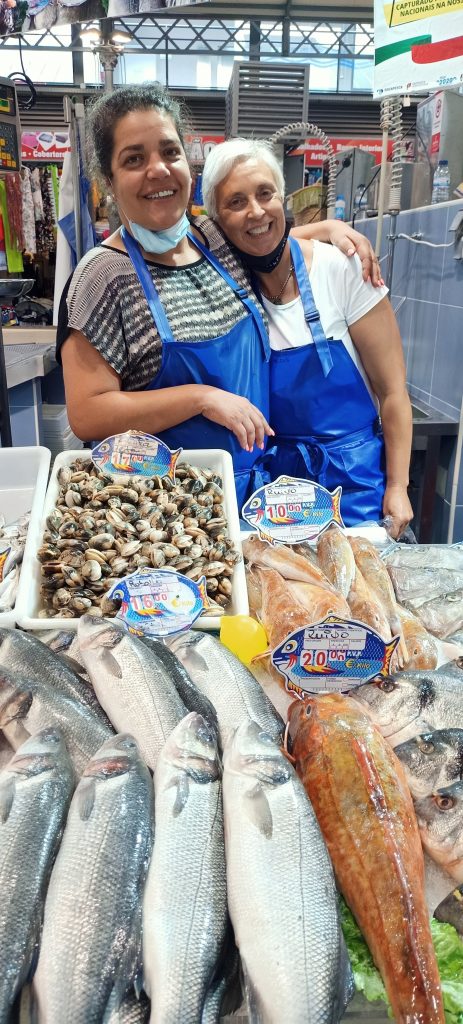
Wonderful. We packed our bags full with local honey and bread and cakes and fresh pineapple and mint and local oranges until we could carry no more and headed back towards the boat, wondering whether we should stay here a few more days. We paused at a charming looking seafront café, considered a quick coffee stop, and then I realised that the two topless, middle-aged, sunburned and tattooed gents sitting there at 10am, drinking pints of beer and moaning loudly about something, were Brits. We switched straight back to speaking German and walked right on by, back to the boat. They may have been the only ones in the whole of the town, but it was enough to put me off completely. That’s the nice thing about sailing – you can always move on.
Next stop – Nazaré.
The journey to Nazaré fairly uneventful but for one incident. I had gone below and Dietmar had been temporarily distracted by something and hadn’t been scanning the horizon as attentively as usual. There was a bang and a strange scraping noise along the hull – I ran up into the cockpit to see a stick right next to the boat – then there was a dreadful noise like a massive blender, then nothing… and then polystyrene like snow on the water behind us. We had hit one of those thousands of fishing pots. And our rope cutter [2]had saved us. Cesarina had simply motored on regardless. A single dolphin blew, once, next to the boat as we continued on our way. I was jittery as anything for a little while afterwards. Hitting one and getting away with it was truly pure luck (and well-maintained machinery) but I really don’t want to test the hypothesis that this rope cutter will work every time :/
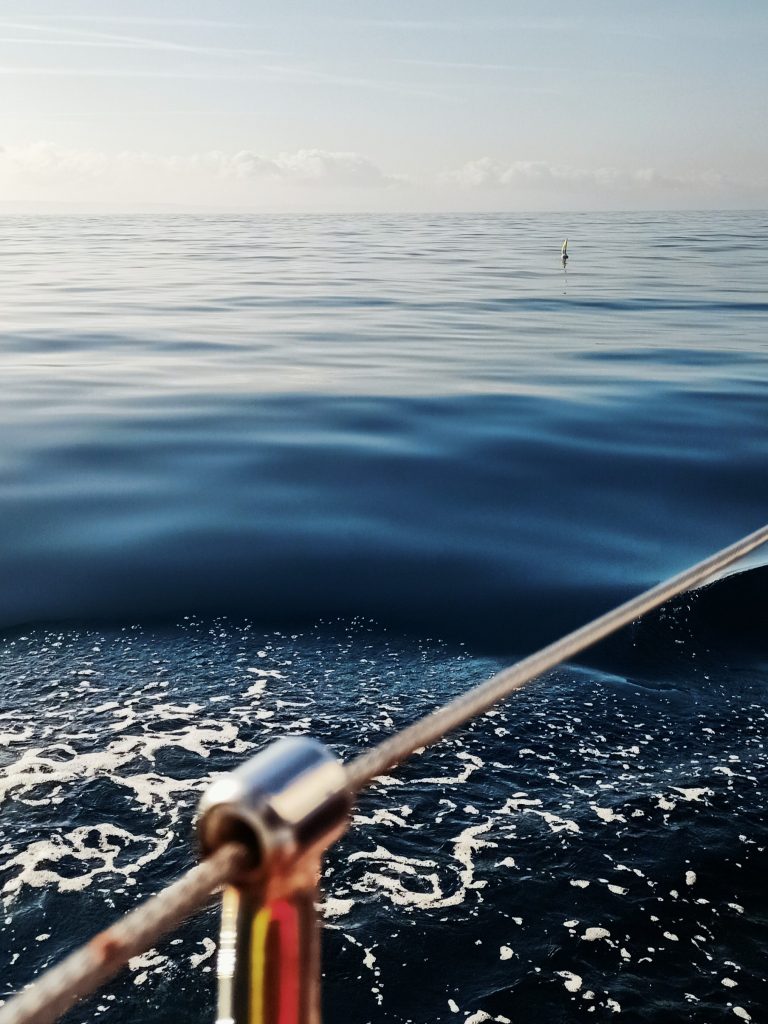
Anyway – famous for its enormous waves, Nazaré is quite the landmark on the map. Dietmar was unsurprisingly a little alarmed when I showed him photos of the huge waves and said “We are definitely not going there…” but there was no wind and no swell as we motored around the headland and through the multiple breakwaters into the marina.
 Nazaré has a certain dissonance, seemingly in transition between the past and the future. There’s a stunning beach, a smallish marina that shares a channel with fishing boats that work day and night, and a ley line to Jerusalem (apparently). The famous black Madonna in the church on the clifftop has attracted pilgrims and an associated line of shops selling vaguely religious tat.
Nazaré has a certain dissonance, seemingly in transition between the past and the future. There’s a stunning beach, a smallish marina that shares a channel with fishing boats that work day and night, and a ley line to Jerusalem (apparently). The famous black Madonna in the church on the clifftop has attracted pilgrims and an associated line of shops selling vaguely religious tat.
Nazaré also happens to be famous for the biggest surfable waves on the planet (many records have been set here in the past ten years since the waves have been ‘discovered’) but it was flat calm while we were there. Despite all these attributes and attractions, it feels like a backwater and remains under-developed and somehow a little tacky. For five euros you can snap up a small resin Christ on the cross with a bit of coral, or for fifteen euros, a 10” tall plastic Mary holding the baby Jesus, also surrounded by seashells. Nazaré ashtrays and mugs and shot glasses are piled high for sale, alongside the obligatory fridge magnets and postcards. Shops on the seafront tout hats and inflatables for the beach, whirling windmills and bubble machines. Young families push buggies and pull toddlers, wailing, away from the sand. Old ladies from the village sit on the roadside on white plastic chairs with laminated signs offering cheap rooms for rent, their black scarves pulled over their heads against the sunshine. We saw a closed surf school on the beach and not a single surf shop, but this is perhaps because the waves in Nazaré are definitely not for beginners. When the surf is up here, the 80’ waves are only surfable if you get a tow in from a jet ski…

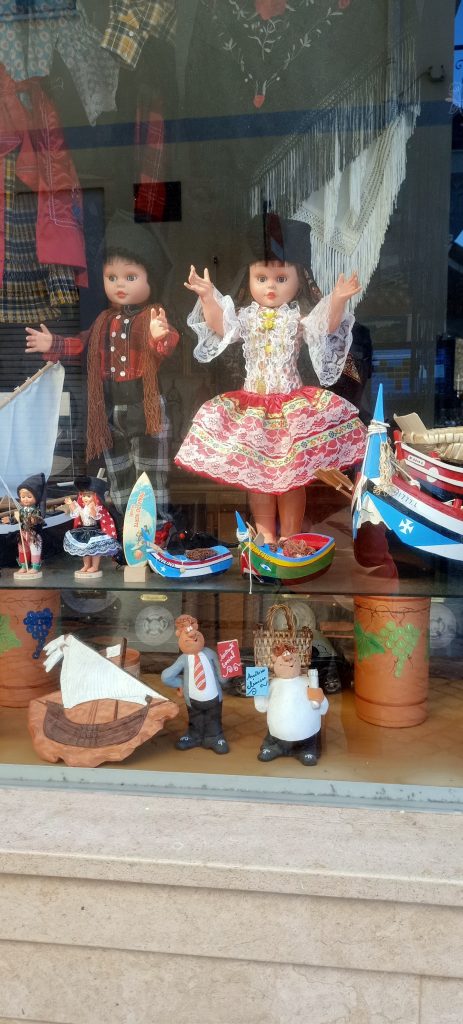

Behind the promenade, wonderfully narrow, cool cobblestone streets revealed perhaps a more real Nazaré, with older men sitting in the shade and smoking; women peeling potatoes and washing hung out to dry. The houses, all painted white or pale pastel colours, with colourful doors, had peeling paintwork and an occasional cat stalking through the quiet, dark blue shadows. We found a shady place full of locals to sip fiercely strong coffee and eat amazing cake; a chic donut stand; a quiet beach bar (with easily the slowest service on the planet) to drink cocktails and watch the sunset with our toes in the sand. We went for an early morning run before it got crazy hot, took my paddleboard out, made the most of the very hot weather with our feet in the water but gave the surfing a miss. We didn’t even take the funicular up to the clifftop to go and see the famous Madonna, the new Burger King or the view down from the lighthouse.
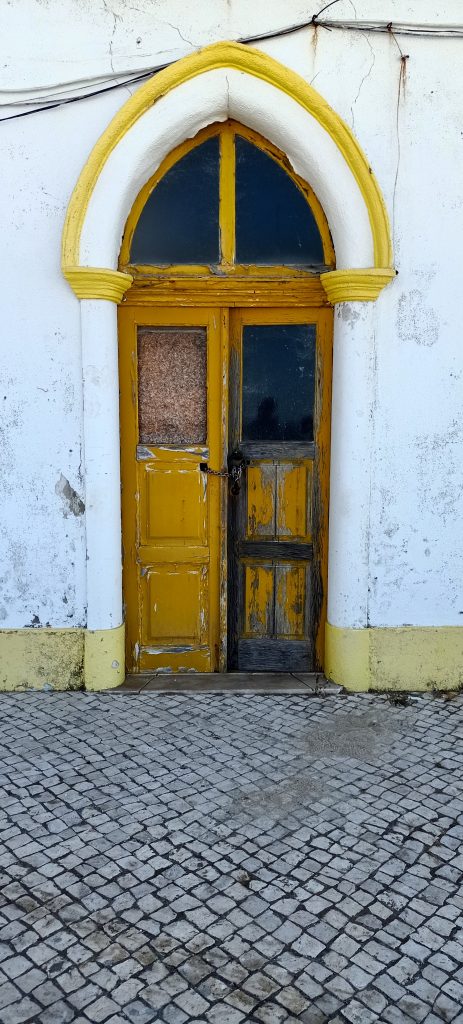


In the marina, we met the Israelis again who we first saw in A Coruña, with their new but problem-ridden catamaran and spent the evening on board with them, discussing everything under the sun. We also, separately, got to know the young French couple of paramedics on Sauve Qui Peut, who have taken a year’s sabbatical to sail and teach basic lifesaving techniques including CPR to school children. We drank Pineau des Charentes with them and I translated back and forth for them and Dietmar. It was a fun evening.
One of the absolute best parts about sailing is meeting new people along the way, and you definitely meet all sorts: Young, fresh-faced couples and weather-worn old men sailing solo; occasionally women alone or in pairs; bachelor boats looking for conditions in which to demonstrate their manhood; retired couples fresh to sailing, hoping to reclaim their freedom which they lost many years ago under a pile of nappies and mortgages; hippies, yuppies, techies, hitchhikers, multi-millionaires, drop outs, eco-warriors, anti-vaxxers. We’ve met extremely experienced bluewater sailors on tiny, wooden boats, and relative beginners on massive factory-new catamarans that they barely know how to park, let alone sail – or fix (and lord knows, brand new boats often seem to need plenty of fixing!). We’ve met happy couples and also couples where the wife has already departed for home in her head, whether or not the husband has actually noticed yet (I would guesstimate the ratio of male to female cruising sailors is comfortably 3:1, and in the racing world women are significantly rarer.). Happy cruising sailors all seem to have one thing in common though – we don’t want ‘normal’. We treasure our ability to move on if our surroundings (or neighbours) don’t please us. We are resilient, we are problem-solvers, we are (generally) relentlessly optimistic; we treasure the little things. We have found our tribe, and it is afloat. It moves with the wind and the weather, like camels across the desert.
After a few nights in this interesting little place, we set sail again, this time for Lisbon… but for this, you will have to wait for the next blog!
Stay safe in the meantime, and take care!
Emma x
[1] An anode is a zinc block the size of several chocolate bars (depends on the size of the boat) fixed to the hull under the water (and often also on the end of the propeller). Electricity in salt water causes electrolysis in metal on boats – it eats it away. This can obviously cause a few problems! Anodes are sacrificial – they ‘collect’ spare electrical current and themselves corrode easily so that the rest of the boat is protected.
[2] We have a double blade that spins with our propeller, to save us in exactly these circumstances. We are very sorry to the fisherman whose float we mangled, but it would be very helpful if they would try to make sure that their pots are really clear, not just barely visible above the surface of the water and therefore impossible to see until you are upon them, or even totally invisible against the sun :/

Delightful. I feel a bit like I am walking those streets with you, looking with delight at colorful doors and windows filled with silly and charming trinkets. You guys are intrepid. If I was on any boat or ship and we hit anything of significance I would lose my marbles. That said, I am good in a “situation” (ask Tim) so I may just keep it together, do whatever needs to be done, and then, once on solid ground, I would lose my marbles and likely find one of those women sitting in plastic chairs offering cheap accommodation. Bless those women.
I look forward to reading more.
Safe Travels, Guys-always.
xo Tracy